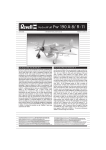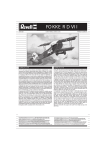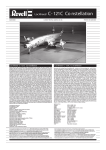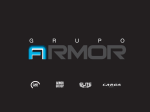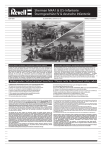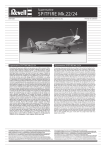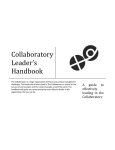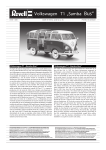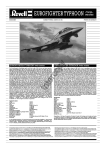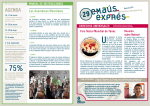Download Type VII C
Transcript
German Submarine 05093-0389 Type V II C 2009 BY RE VE LL GmbH & CO. KG German Submarine Type V II C El Tipo VII C se desarrolló paulatinamente desde el principio de la década de 1930 a partir de las llamadas “canoas”, unos submarinos pequeños con poca autonomía que se utilizaban en el mar del Norte y el Báltico. La armada alemana quería un nuevo tipo de sumergible con el que combatir en las zonas Este, Norte y el centro del Atlántico. Su objetivo era cortar las líneas de abastecimiento inglesas. Entre 1935 y 1937, se construyeron diez embarcaciones Tipo VII A con el característico tanque sobre la caldera. El Tipo VII B tenía unos motores más potentes y era 2m más largo. El Tipo VII C se equipó con un dispositivo sonar activo y una torre de mando mayor, además del puente. Entre 1938 y 1944, este tipo de embarcación se construyó cada vez más en un total de 16 astilleros alemanes. En total, se botan 664 de estas naves monocasco. Se convirtió en el submarino más numeroso de la Segunda Guerra Mundial. Las placas de acero del casco de presión tenían 18,5mm de grosor, lo que le permitía sumergirse a 100m. No obstante, en caso de emergencia llegaba a descender 250m. Además de los torpedos, también podían llevar lanzadores de minas, que colocaban en las entradas de los puertos. En la cubierta delante de la torre se encuentra un cañón superficie-superficie de 88mm sobre una plataforma giratoria central, el cual podía disparar proyectiles a una distancia de hasta 12,35km. Uno de los ataques más efectivos de este arma fue el ataque a la central eléctrica inglesa de Jaff (cerca de Tel Aviv). Pero al principio se utilizaba sobre todo para obligar a detenerse a los mercantes. En la torreta detrás de la cubierta se encontraba un cañón antiaéreo de 2cm. Además de 4 oficiales. y 5 sargentos, la tripulación estaba formada por 9 suboficiales y 20 soldados, que a menudo tenían que compartir un espacio muy reducido durante semanas. El Tipo VII C operó en el Norte y el centro del Atlántico, en África, el mar Caribe y Mediterráneo, Groenlandia, la costa oriental del Norte de América y Canadá, el mar del Norte y el Ártico. Las tácticas de ataque a convoyes cambiaron mucho cuando Gran Bretaña entró en la guerra. Los submarinos seguían los buques, informaban de su posición, acompañaban a los buques de guerra y los atacaban con sus torpedos durante la noche. Durante su “época afortunada” en 1940 y 1941, los U-Boot alemanes consiguieron hundir muchas embarcaciones enemigas, tanto buques de guerra como mercantes. Sin embargo, a partir de 1941 la situación cambió drásticamente. Los métodos enemigos de detección y el reconocimiento aéreo mejoraron notablemente y las embarcaciones empezaron a “desaparecer”. De los 39.000 hombres que formaban la tripulación de los submarinos alemanes, más de 33.000 perdieron la vida en el mar. Con este modelo, podrá contemplar el ascenso y la caída de los U-Boot alemanes. PRINTED IN GERM ANY German Submarine Type V II C The Type VII C was gradually developed from the beginning of the 1930s from the so -called “canoes ” – small short -range submarines suitable f or use in the North Sea and the Baltic . The aim of the German Nav al Command w as to obtain a new type of submersible with which the futur e main combat zones in the eastern , north and mid Atlantic could be reached in order to take action against the English supply lines. Betw een 1935 and 1937, ten vessels of Type VII A we re built with the characteristic saddle tank . The type VII B then received more pow erful engines and the vessel was lengthened by 2 m. The Type VII C received an active sonar device and larger conning tow er and bridge and betw een 1938 and 1944 was built in steadily increasing numbers at a total of 16 German shipyards. 664 of this single-hulled vessel we re launched. They represent the most numerous submarine type of the Second World War. The steel plates of the pressure hull we re 18.5 mm thick. This enabled it to submerge down to a depth of about 100 m. How ever in an emergency many withstood a maximum depth of 250 m. In addition to torpedoes they could also carry torpedo tube mines to enable them to mine the approaches to harbours . On deck forw ard of the tow er there was a 88 cm surface-to-surface cannon on a centre pivot mount that could fire projectiles to a distance of 12.35 km . One of the most eff ective uses of this we apon wa s the shelling by U-81 of the British electric pow er station at Jaff a (near pr esent day Tel Aviv). At the beginning how ever it was mostly used to force merchant vessels to stop by firing a shot acr oss the bows . In the turr et aft of the tow er stood a 2 cm anti-aircraft gun. In addition to 4 officers and 5 staff sergeants , there we re 9 non-commissioned officers and 20 ratings, who we re often accommodated aboard in closely confined space for weeks on end. Type VII C vessels we re used in the north and mid Atlantic , off Africa , in the Caribbean and the Mediterr anean, off Greenland, the east coasts of North America and Canada and in the North Sea up into Ar ctic waters east of Murmansk . Their tactics for attacking conv oys alter ed soon after Gr eat Britain enter ed the wa r in that during the day the submarines tracked them and reported their position and accompanying wa rships and then, submerged under cover of night, attacked the ships at close range with torpedoes . Thus during the “lucky period” in 1940 and 1941 it was possible for the German U-boats to achieve considerable successes in sinking enemy wa rships and merchant tonnage. From Mar ch 1941 how ever this scene changed suddenly and very drastically. The enemy methods of locating and air reconnaissance we re so much improved that the vessels suddenly “disappeared”. Thus out of about 39,000 submarine crewmen ov er 33,000 lost their liv es at sea . The rise and f all of the German Uboat is impressively reflected in this model. 05093 05093 Verwendete Symbole / Used Symbols Bitte beachten Sie folgende Symbole, die in den nachfolgenden Baustufen verwendet werden. Veuillez noter les symboles indiqués ci-dessous, qui sont utilisés dans les étapes suivantes du montage. Sírvanse tener en cuenta los símbolos facilitados a continuación, a utilizar en las siguientes fases de construcción. Si prega di fare attenzione ai seguenti simboli che vengono usati nei susseguenti stadi di costruzione. Huomioi seuraavat symbolit, joita käytetään seuraavissa kokoamisvaiheissa. Legg merke til symbolene som benyttes i monteringstrinnene som følger. Prosz´ zwa˝aç na nast´pujàce symbole, które sà u˝yte w poni˝szych etapach monta˝owych Daha sonraki montaj basamaklar›nda kullan›lacak olan, afla¤›daki sembollere lütfen dikkat edin. Kérjük, hogy a következŒ szimbólumokat, melyek az alábbi építési fokokban alkalmazásra kerülnek, vegyék figyelembe. Abziehbild in Wasser einweichen und anbringen Soak and apply decals Mouiller et appliquer les décalcomanies Transfer in water even laten weken en aanbrengen Remojar y aplicar las calcomanías Pôr de molho em água e aplicar o decalque Immergere in acqua ed applicare decalcomanie Blöt och fäst dekalerna Kostuta siirtokuva vedessä ja aseta paikalleen Fukt motivet i varmt vann og før det over på modellen Dypp bildet i vann og sett det på è‚ӉÌÛ˛ ͇ÚËÌÍÛ Ì‡ÏÓ˜ËÚ¸ Ë Ì‡ÌÂÒÚË Zmi´kczyç kalkomani´ w wodzie a nast´pnie nakleiç βουτÜξτε τη χαλκοµανÝα στο νερÞ και τοποθετεÝστε την Ç›kartmay› suda yumuflat›n ve koyun Obtisk namoãit ve vodû a umístit a matricát vízben beáztatni és felhelyezni Preslikaã potopiti v vodo in zatem nana‰ati Kleben Glue Coller Lijmen Engomar Colar Incollare Limmas Liimaa Limes Lim äÎÂËÚ¸ Przykleiç κÞλληµα Yap›flt›rma Lepení ragasztani Lepiti Wahlweise Optional Facultatif Naar keuze No engomar Alternado Facoltativo Valfritt Vaihtoehtoisesti Valgfritt Valgfritt ç‡ ‚˚·Ó Do wyboru εναλλακτικÀ Seçmeli Volitelnû tetszés szerint naãin izbire Please note the following symbols, which are used in the following construction stages. Neem a.u.b. de volgende symbolen in acht, die in de onderstaande bouwfasen worden gebruikt. Por favor, preste atenção aos símbolos que seguem pois os mesmos serão usados nas próximas etapas de montagem. Observera: Nedanstående piktogram används i de följande arbetsmomenten. Læg venligst mærke til følgende symboler, som benyttes i de følgende byggefaser. Παρακαλñ προσÛξτε τα παρακÀτω σàµβολα, τα οποÝα χρησιµοποιοàνται στι̋ παρακÀτω βαθµÝδε̋ συναρµολÞγηση̋. Dbejte prosím na dále uvedené symboly, které se pouÏívají v následujících konstrukãních stupních. Prosimo za Va‰u pozornost na sledeãe simbole ki se uporabljajo v naslednjih korakih gradbe. 1. Zusammenbau-Reihenfolge Sequence of assembly Ordre d'assemblage Volgorde van montage Orden de montaje Ordine di montaggio Ordem de montagem Monteringsrekkefølge Kokoamisjärjestys Monteringsföljd Rækkefølgen af monteringen èÓÒΉӂ‡ÚÂθÌÓÒÚ¸ ÏÓÌڇʇ Összeszerelési sorrend AκολουθÝα συναρµολÞγηση̋ Kurmak-Sıra KolejnoÊç monta˝u Vrstni red sestavljanja MontáÏ - postup Klebeband Adhesive tape Dévidoir de ruban adhésif Plakband Cinta adhesiva Fita adesiva Nastro adesivo Tejp Teippi Tape Tape äÎÂÈ͇fl ÎÂÌÚ‡ TaÊma klejàca κολλητικÜ ταινÝα Yap›flt›rma band› Lepicí páska ragasztószalag Traka z lepilom Mit einem Messer abtrennen Detach with knife Détacher au couteau Met een mesje afsnijden Separarlo con un cuchillo Separar utilizando uma faca Staccare col coltello Skär loss med kniv Irrota veitsellä Adskilles med en kniv Skjær av med en kniv éÚ‰ÂÎflÚ¸ ÌÓÊÓÏ Odciàç no˝em διαχωρÝστε µε Ûνα µαχαÝρι Bir b›çak ile kesin Oddûlit pomocí noÏe kés segítségével leválasztani Oddeliti z noÏem Beiliegenden Sicherheitstext beachten / Please note the enclosed safety advice D: Beiliegenden Sicherheitstext beachten und nachschlagebereit halten. GB: Please note the enclosed safety advice and keep safe for later reference. F: Respecter les consignes de sécurité ci-jointes et les conserver à portée de main. NL: Houdt u aan de bijgaande veiligheidsinstructies en hou deze steeds bij de hand. E: Observar y siempre tener a disposición este texto de seguridad adjunto. I. Seguire le avvertenze di sicurezza allegate e tenerle a portata di mano. P: Ter em atenção o texto de segurança anexo e guardá-lo para consulta. S: Beakta bifogad säkerhetstext och håll den i beredskap. FIN: Huomioi ja säilytä oheiset varoitukset. DK: Overhold vedlagte sikkerhedsanvisninger og hav dem liggende i nærheden. N: Ha alltid vedlagt sikkerhetstekst klar til bruk. RUS: ëo·Î˛‰‡Ú¸ ÔË·„‡ÂϸiÈ ÚeÍÒÚ ÔÓ ÚexÌËÍ ·eÁÓÔ‡ÒÌÓÒÚË, x‡ÌËÚ¸ Â„Ó ‚ ΄ÍÓ ‰ÓcÚÛÔÌÓÏ ÏÂÒÚÂ. PL: Stosowaç si´ do za∏àczonej karty bezpieczeƒstwa i mieç jà stale do wglàdu. GR: ΠροσÛξτε τι̋ συνηµµÛνε̋ υποδεÝξει̋ ασφÀλεια̋ και φυλÀξτε τι̋ Ûτσι ñστε να τι̋ ÛχÛτε πÀντα σε διÀθÛσÜ σα̋. TR: Ekteki güvenlik talimatlarını dikkate alıp, bakabileceginiz bir sekilde muafaza ediniz. CZ: Dbejte na pfiiloÏen˘ bezpeãnostní text a mûjte jej pfiipraven˘ na dosah. H: A mellékelt biztonsági szöveget vegye figyelembe és tartsa fellapozásra készen! SLO: PriloÏena varnostna navodila izvajajte in jih hranite na vsem dostopnem mestu. PAGE 3 05093 Benötigte Farben / Used Colors Benötigte Farben Required colours Peintures nécessaires Benodigde kleuren B granitgrau, matt 69 granite grey, matt gris granit, mat granitgrijs, mat gris granito, mate cinzento granito, fosco grigio granito, opaco granitgrå, matt graniitinharmaa, himmeä granitgrå, mat granittgrå, matt ÒÂ˚È „‡ÌËÚ, χÚÓ‚˚È granitowoszary, matowy γκρι γρανÝτη, µατ granit grisi, mat Ïulovû ‰edá, matná gránitszürke, matt granitno siva, mat H blaugrau, matt 79 greyish blue, matt gris-bleu, mat blauwgrijs, mat gris azulado, mate cinzento azulado, fosco grigio blu, opaco blågrå, matt siniharmaa, himmeä blågrå, mat blågrå, matt ÒËÌÂ-ÒÂ˚È, χÚÓ‚˚È siwy, matowy γκριζοµπλÛ, µατ mavi gri, mat modro‰edá, matná kékesszürke, matt plavo siva, mat 50 % C 50 % messing, metallic 92 brass, metallic laiton, métalique messing, metallic latón, metalizado latão, metálico ottone, metallico mässing, metallic messinki, metallikiilto messing, metallak messing, metallic ·ÚÛÌÌ˚È, ÏÂÚ‡ÎÎËÍ mosiàdz, metaliczny ορεÝχαλκου, µεταλλικÞ pirinç, metalik mosazná, metalíza sárgaréz, metáll mesing, metalik I grau, seidenmatt 374 grey, silky-matt gris, satiné mat grijs, zijdemat gris, mate seda cinzento, fosco sedoso grigio, opaco seta grå, sidenmatt harmaa, silkinhimmeä grå, silkemat grå, silkematt ÒÂ˚È, ¯ÂÎÍÓ‚ËÒÚÓ-χÚÓ‚˚È szary, jedwabisto-matowy γκρι, µεταξωτÞ µατ gri, ipek mat ‰edá, hedvábnû matná szürke, selyemmatt siva, svila mat M Colori necessari Använda färger D staubgrau, matt 77 dust grey, matt gris poussière, mat stofgrijs, mat ceniciento, mate cinzento de pó, fosco grigio sabbia, opaco dammgrå, matt pölynharmaa, himmeä støvgrå, mat støvgrå, matt ÒÂ˚È Ô˚ÎËÒÚ˚È, χÚÓ‚˚È szary kurz, matowy χρñµα σκÞνη̋, µατ toz grisi, mat prachovû ‰edá, matná porszürke, matt prah siva, mat hellgrau, seidenmatt 371 + light grey, silky-matt gris clair, satiné mat lichtgrijs, zijdemat gris claro, mate seda cinzento claro, fosco sedoso grigio chiaro, opaco seta ljusgrå, sidenmatt vaaleanharmaa, silkinhimmeä lysegrå, silkemat lysgrå, silkematt Ò‚ÂÚÎÓ-ÒÂ˚È, ¯ÂÎÍÓ‚ËÒÚÓ-χÚÓ‚˚È jasnoszary, jedwabisto-matowy ανοιχτÞ γκρι, µεταξωτÞ µατ aç›k gri, ipek mat svûtle‰edá, hedvábnû matná világosszürke, selyemmatt svetlo siva, svila mat PAGE 4 Pinturas necesarias Tintas necessárias 50 % + 50 % farblos, matt 2 clear, matt incolore, mat kleurloos, mat incoloro, mate incolor, fosco trasparente, opaco färglös, matt väritön, himmeä farveløs, mat klar, matt ·ÂÒˆ‚ÂÚÌ˚È, χÚÓ‚˚È bezbarwny, matowy Àχρωµο, µατ renksiz, mat bezbarevná, matná színtelen, matt brezbravna, mat farblos, matt 2 clear, matt incolore, mat kleurloos, mat incoloro, mate incolor, fosco trasparente, opaco färglös, matt väritön, himmeä farveløs, mat klar, matt ·ÂÒˆ‚ÂÚÌ˚È, χÚÓ‚˚È bezbarwny, matowy Àχρωµο, µατ renksiz, mat bezbarevná, matná színtelen, matt brezbravna, mat Tarvittavat värit Du trenger følgende farger E Nødvendige farger çÂÓ·ıÓ‰ËÏ˚ ͇ÒÍË Potrzebne kolory Απαιτοàµενα χρñµατα F silber, metallic 90 silver, metallic argent, métalique zilver, metallic plata, metalizado prata, metálico argento, metallico silver, metallic hopea, metallikiilto sølv, metallak sølv, metallic Ò·ËÒÚ˚È, ÏÂÚ‡ÎÎËÍ srebro, metaliczny ασηµÝ, µεταλλικÞ gümüfl, metalik stfiíbrná, metalíza ezüst, metáll srebrna, metalik G eisen, metallic 91 steel, metallic coloris fer, métalique ijzerkleurig, metallic ferroso, metalizado ferro, metálico ferro, metallico järnfärg, metallic teräksenvärinen, metallikiilto jern, metallak jern, metallic ÒڇθÌÓÈ, ÏÂÚ‡ÎÎËÍ ˝elazo, metaliczny σιδÜρου, µεταλλικÞ demir, metalik Ïelezná, metalíza vas, metáll Ïelezna, metalik J laubgrün, seidenmatt 364 leaf green, silky-matt vert feuille, satiné mat bladgroen, zijdemat verde follaje, mate seda verde gaio, fosco sedoso verde foglia, opaco seta lövgrön, sidenmatt lehdenvihreä, silkinhimmeä løvgrøn, silkemat løvgrønn, silkematt ÎËÒÚ‚ÂÌÌÓ-ÁÂÎÂÌ˚È, ¯ÂÎÍ.-χÚÓ‚˚È zielony liÊciasty, jedwabisto-matowy πρÀσινο φυλλωµÀτων, µεταξ. µατ yaprak yeflili, ipek mat zelená jako listí, hedvábnû matná lombzöld, selyemmatt list zelena, svila mat Gerekli renkler Potfiebné barvy feuerrot, seidenmatt 330 fiery red, silky-matt rouge feu, satiné mat rood helder, zijdemat rojo fuego, mate seda vermelho vivo, fosco sedoso rosso fuoco, opaco seta eldröd, sidenmatt tulipunainen, silkinhimmeä ildrød, silkemat ildrød, silkematt Ó„ÌÂÌÌÓ-͇ÒÌ˚È, ¯ÂÎÍ.-χÚÓ‚˚È czerwony ognisty, jedwabisto-mat. κÞκκινο φωτιÀ̋, µεταξωτÞ µατ atefl k›rm›z›s›, ipek mat ohnivû ãervená, hedvábnû matná tızpiros, selyemmatt ogenj rdeãa, svila mat K schwarz, seidenmatt 302 black, silky-matt noir, satiné mat zwart, zijdemat negro, mate seda preto, fosco sedoso nero, opaco seta svart, sidenmatt musta, silkinhimmeä sort, silkemat sort, silkematt ˜ÂÌ˚È, ¯ÂÎÍÓ‚ËÒÚÓ-χÚÓ‚˚È czarny, jedwabisto-matowy µαàρο, µεταξωτÞ µατ siyah, ipek mat ãerná, hedvábnû matná fekete, selyemmatt ãrna, svila mat Szükséges színek. Potrebne barve 05093 PAGE 5 05093 PAGE 6 05093 18 8 17 PAGE 7 05093 19 PAGE 8 20








